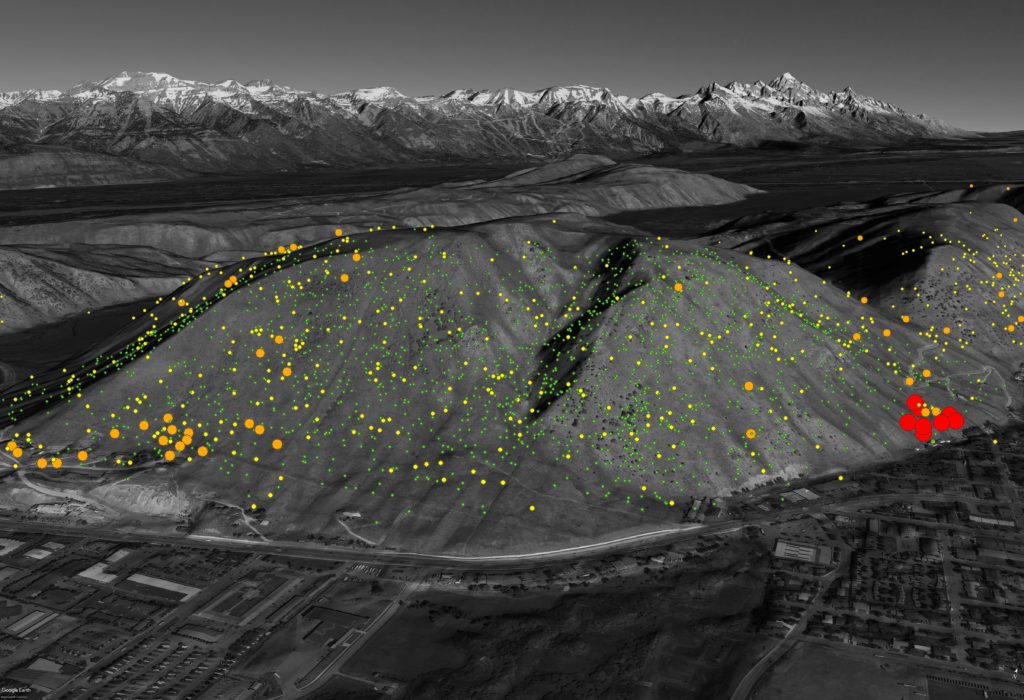By Morgan Graham, Teton Conservation District
Growing up in Pennsylvania, I was not intimately familiar with the concept of winter range. Seasonal shifts were marked by hundreds of Canada geese gorging on leftover corn and soybeans. Over time more and more of those migrating geese became yearlong residents, displacing other waterfowl and depositing metric tons of green slipping hazards on sports fields…but that’s a different story. Winter range showed up on my radar in a big way during my first winter in Jackson in 2006. As part of a field technician position, I counted mule deer on winter range from 27 fixed locations around the valley twice a week. Over the following three winters, I listened to a lot of Trash and Treasure, documented 3,230 animals across 417 locations, and developed a greater appreciation for winter range. Monitoring conservation easements, conducting habitat inventories, and 15 seasons exploring public lands have deepened my understanding of why winter range is important.

So, what’s winter range anyway and why should you care about it?
The lack of winter range is widely recognized as one of the most significant limiting factors to mule deer populations. Winter range is the topography, and habitat that mule deer require to survive deep snow, frigid temperatures, predation threats, and human-caused stress. The winter range we see animals using most frequently are the steep south-, east-, and west-facing buttes that receive enough sun and wind to keep snow depths low and natural high-fiber forage accessible, like mountain big sagebrush, Rocky Mountain juniper, antelope bitterbrush, rubber rabbitbrush, Wood’s rose, mountain snowberry, and curlleaf mountain mahogany. It also includes older, closed-canopy stands of Douglas fir and lodgepole pine that shield against heavy snow and cold wind.
When I was a young buck, my body mass could fluctuate by 15% over the year (mule deer bucks can lose 15% of their body mass during the rut alone!). A steady winter diet of beer, pizza, and Netflix transitioning to a summer diet of sunshine, water, and plants would typically put me at my heaviest in April and lightest in October. Mule deer are the opposite. Their fat levels may increase from around 9% in June to 25% in December. They then rely on those fat stores until May when the landscape begins to green up again. If they run out, their body will shift to burning protein/muscle (not good). A dog chasing a deer through deep snow has negative consequences―travel through snow can require 6x more energy than flat ground. What’s harder to reckon are the cumulative impacts of more frequent alertness, standing, and walking in response to humans and pets. Each act of avoidance is a debit on a deer’s fat stores. The best thing you can do is keep your dog under control and observe seasonal wildlife closures. Even if there isn’t snow on the ground, the deer appreciate the space to chill.
So, why we don’t just feed deer the same way we feed elk? There are plenty of biological, social, and behavioral reasons, but the simplest is that it can kill them. Mule deer have evolved to “stomach” our long winters. Deer are heavily reliant on rumen bacteria that adjust seasonally to the foods that are available on the landscape. By the time winter rolls around, a deer’s rumen has acclimated to handle high-fiber, low-protein food. Suddenly dumping high-protein or high-carb fuel like hay or corn in the tank is equivalent to putting gasoline in a diesel engine (also not good). If you want to provide food for wildlife, consider maintaining or restoring some of the native plants listed above in areas away from buildings and roads.
Organizations like Jackson Hole Wildlife Foundation play an invaluable role in amplifying the importance of crucial habitats like mule deer winter range. If you want to help, consider sharing some of the concepts of this post with friends or become a certified Nature Mapper and start logging observations of all sorts of critters on winter and other seasonal ranges. Morgan is the Geographic Information Systems (GIS) & Wildlife Specialist for Teton Conservation District. He is grateful for the opportunity to behold and share the hidden gems of the Greater Yellowstone Ecosystem with friends, family, and curious strangers. Follow along @morganser and @tetonconservation or send him notes or questions at morgan@tetonconservation.org.
